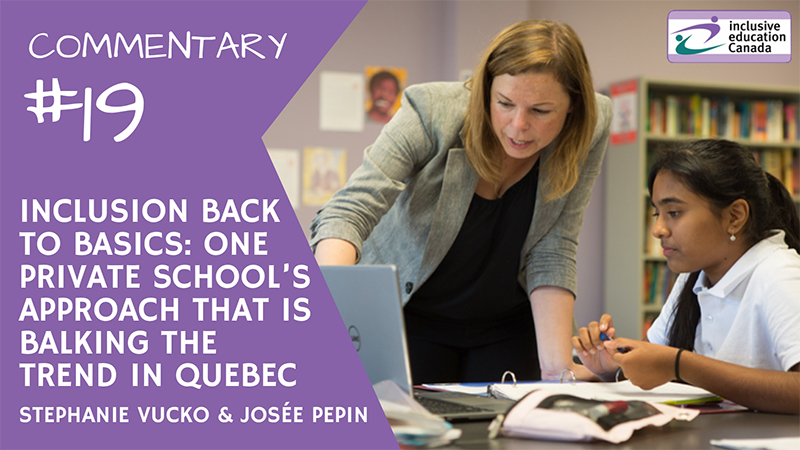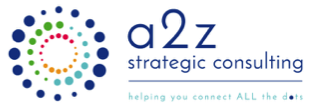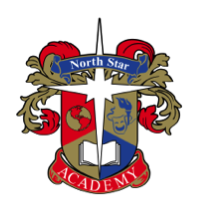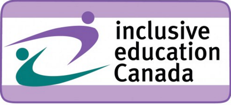 National Inclusive Education Month Commentary #19
National Inclusive Education Month Commentary #19
By Stephanie Vucko, CEO a2z strategic consulting, Montreal, PQ and Josée Pepin, Head of School, North Star Academy Laval
Introduction
Having recently transitioned from 23 years of leadership and inclusion work in the public education sector to running a private consulting firm, I have seen training sessions, key note speakers, resource materials, staffing structures, and instructional models come and go, some stuck, many were a passing trend that changed as budgets fluctuated or leaders moved on. The one element that remains consistent in inclusion conversations over the years is the role of the teacher in the classroom, the role of the student as steward of their learning and the importance of a strong school-home relationship. I wanted to share with you how one school team have approached inclusion by going back to the basics.
I recently had the opportunity to delve into the private education system of Quebec, guiding strategic change with the Head of School and owner, Ms. Josée Pepin, of a uniquely inclusive school that balks the private school stigma of exclusion and welcomes ALL students into the North Star Academy family of learners.
Public versus Private Schools Options in Quebec for Learners with Special Needs
Public and private education sectors in the province of Quebec are highly competitive, especially when minority English-speaking community representation hovers around 10% of the population dispersed across a large geographic area. Partnerships are rare and collegiality and best practice sharing at provincial tables between public sector leaders and private sector owners are often more proprietary than collaborative. The fully private schools receive no government funding and must sustain themselves on enrolment from a dwindling minority population—many are in crisis and talks of closures and mergers of private schools, historical institutions in the fabric of the English-speaking community, are becoming a reality. But not for one school that is balking this trend, with a 25% increase in student population in the last two years—the formula is quite simple: everyone is welcome to learn at North Star Academy Laval.
Bill 101 Favours Students with Special Needs
Limits set on access to English education through the infamous Quebec Bill 101, limit options for access to English education for students. Interestingly, the exception is for those students with diagnosed special needs or learning difficulties, who have the right to attend the English school of their choice, outside of the parameters of Bill 101. Unfortunately, this choice is often muddled with confusion. For instance, the only other public option for a parent whose child may not be in the best setting, is usually not the next neighbouring English school, as schools are often far apart, with bussing only available if you live ‘in zone’ and geography being such that it is impossible to transport your child across a region each day. Another choice, which is often riddled with myths and perceptions, is to attend a private school that can seem financially and academically unattainable. But not all private schools are the same. North Star Academy Laval did things differently from the onset with a vision of inclusion for all.
Vision for Inclusion in One Private High School
“Welcome to North Star Academy Laval (NSAL), where your children are our priority.” Not just a catch phrase spoken by the Head of School of a small and unique private school serving the minority English community in Laval, Quebec. When high school options were limited, and the only English private school was an
inconceivable 90-minute daily commute into Montreal, the vision of Ms. Josée Pepin, owner, was simple: build a private school that was accessible and that would meet the needs of all learners where everyone would feel safe and welcome. Moreover, add to that a Polaris Foundation that would provide financial support on a case-by-case basis, not only scholarships for high achievers, so everyone could afford to attend. And she did just that, balking the trend of exclusionary private schools in Quebec.
Inclusion Begins with a Vision: Strategic Plan Renewal
NSAL recently celebrated its 10-year anniversary, still considered a newbie on the private school scene. During strategic plan renewal, Josée and her team of teachers have undergone two years of ongoing reflective discussions, professional development and strategic planning to envision the NSAL of the future. At the heart of these discussions was how to best serve their increasingly diverse population through everyday teaching practices. A trend in recent years saw NSAL seeing increased registration of students switching from public and private institutions to NSAL because parents heard that the school made things work.
Inclusion Back to Basics: 4 Basic steps that support learners at NSAL
North Star Academy Laval is a non-subsidized private high school, the only English private school on the North Shore of Montreal. It serves 140 students from grades 7-11 and its staff are comprised of 11 teachers, one office manager, a secretary, and new in 2017, a school principal—along with the Head of School. There are no additional resource teachers, technicians, aids, counsellors, speech therapists or psychologists—just the one teacher in her or his classroom with 15-25 students.
STEP 1 to Inclusion: Best placement
When a parent comes into NSAL for that first meeting to register their child with special needs, one of the first things Josée assesses is: is this the best setting for the student. There is no delusion that the one teacher approach is the best for all learners, Josée conducts all her intake interviews, now in collaboration with the principal, and the conversation is with the parents and the potential student to see what the needs are. Parents often come to NSAL through word of mouth, from specialized private or public schools where things just were not working out, despite the plethora of resources available. Approximately 15% of the students enrolled at NSA have special needs. In ten years, Josée has only turned away 2 students whose needs required medical intervention and where academics were not the primary need. Josée makes it clear that there are no specialized resources at the school; the key specialists are the classroom teacher, the parent and the student. If there is a fit, then the welcoming process begins. A community approach allows Josée to build partnerships and make referrals to outside resources when parents need additional support.
STEP 2 to Inclusion: Student-Parent-School Team Relationship is a priority
Parents are important education partners at NSAL. “We have to know we can support them with what we have, it is the only way their child will succeed,” insists Pepin, “and the parents need to know that they are in on this too, we demand a lot of home support from our parents, this is not for everyone, either.” Josée reflects on the 10 years saying “We have tried various models over the years, at times having a special care counsellor on site, or a guidance counsellor—but in the end, it ends up with who is in that classroom day in and day out—the teacher and students. Right now, the focus is on empowering those teachers in their pedagogy so they have what they need to guide all the students. And strengthening student learning through community connections, strategic learning and teaching the whole child, after all, they are teens! And they want to know that what we are doing has some meaning and purpose in ‘the real world’.”
STEP 3 to Inclusion: Establish communications at the onset
There are many things that transpire upon registration, from a welcome package, to clear communication practices with access to a communication portal, with IEP review processes and 10 meetings scheduled, to parents being provided with access to everyone’s email and with a 1-day communication returned policy for staff. Parents tour the school with their child, meeting each teacher and all student classes. In the first week, the student and his or her parent are asked to set goals, identify interest areas and areas of concern. These become the springboard for registration to in school Extra-Curricular Activities, “key to the socialization aspect of an education—they have to like being here!” enthuses Josée. Parents are welcome any time and do pop into the office for a quick discussion, a check-in and receive calls from teachers and administration almost weekly. “New parents often get nervous when receiving these first calls, often having had negative past education experiences with their child, when a call usually meant a complaint of some sort” comments Pepin. The rule of thumb at NSAL is a call of praise builds relationships with parents and students first, before you can call with concerns.
3.1 Making IEPs living documents
One of the greatest challenges of even the best IEPs is to keep things at the forefront once the paper document is filed. So much time is spent identifying strategies that will work, on paper, and then the real work begins by putting these into daily practice. Students are required to attend their IEP meetings with one or more parents/guardians, 2-3 teachers and the school principal attend. Everyone takes note of what was decided. Teachers keep track weekly of strategies and the progress of the student in a simple Excel table that all teachers have access to. These strategies are at times incorporated into the goal-setting and action plan process described earlier.
3.2 Red Flags at Staff meetings
Monthly staff meetings begin with a section called Red Flags. This is an informal discussion where a teacher can ‘red flag’ a student, express a concern or worry from academic, social, emotional or changes in behaviour and a quick brainstorm occurs to see if others are having the same difficulties, noticing similar issues and if anyone has a suggestion as to how to take a next step with the student. Strategies are put in place, often more than one teacher teaming to tackle things, discreetly, with one of the students of concern. Other times, teachers share successes and progress with students who had been red flagged in the past. The principal keeps track and brings back red flagged students at the next meeting to ensure no one slips through the cracks. When a student with special needs or learning difficulties is red flagged, teachers remind each other of IEP strategies that are working, and at times need to make changes to strategies when a the strategy is no longer effective.
3.3 Call list
At the same time, a call list is created to see if there are calls of praise or concern, and to see who will make the main call. This is critical for positive communication with the home, especially in the case of parents whose child has struggled in school over the years, they do not need three calls to tell them their son has been off the wall or forgotten to submit work from four teachers. One teacher communicates the concern on behalf of the team, and if required, a face-to-face meeting follows.
STEP 4 to Inclusion: Invest in your Teachers
As part of the new NSAL Strategic Plan, one entire Pillar in the plan is focused on Investing in Staff. Josée has dedicated time and budget to support her team over the last years with a few key elements highlighted below as being instrumental for creating an inclusive learning environment.
4.1 Goal setting and conferencing towards student self-regulation
Struggles, failures or concerns are nothing to fear at NSAL—these become springboards areas for improvement and are documented each term through an individualized goal setting practice put in place a few years ago, whereby all students set goals each term, monitoring and reflecting on these goals monthly and conferencing with their teacher advisor team each term. Self-regulation is the key, students are firmly told when they join NSAL that they are the key to their success that the staff and their parents will support but in the end, they, the student must do—learning is hard work.
4.2 Guiding Self-Regulation
At a staff meeting, Josée reminds the team of the importance of guiding students to develop competency in self- regulation: “Students who struggle with learning are facing greater challenges than failing your History quiz or Response activity in ELA. They often struggle with being self-regulated—they just can’t seem to get all the pieces going together at once. Therefore, if we focus on the result of their learning difficulty—failure of a test or assignment—we never get to really teaching to what the students need.” The school supports the education of the whole child—from locker organization, to planning your project work, to learning how to work with others and communicate positively—it is all an integral part of their learning. Not easy words for all to hear, and not as simple as one sentence written here, these words are communicated at Monday morning assemblies, through House teams and one-on-one tutoring with teachers, though feedback on assignments and on-going discussions at staff meetings.
4.3 Rewarding what you value
Sure, there are the usual awards for top marks, but Josée and the team know that a 21st century world needs diverse citizens—and the kids are reminded of this weekly. To encourage a range of learning success, newly added with the strategic renewal are term-based awards for students who can demonstrate proof that they have achieved their term goal.
4.4 Learning goals for the class
Each class, teachers set learning goals for the class period to ensure everyone knows what is expected that class and teachers ask students to reflect at the end of class in a variety of ways from exit cards, to individual check-ins to round-table group reflection—this becomes the basis of the next class lesson. These goals are part of the report card meetings and allow teachers to personalize education around each learner, knowing what they want to achieve.
4.5 Professional Learning Community
The teacher PLCs are still new and evolving—but the predominant theme is differentiation. Through curriculum mapping that is in progress, the teachers are front-end designing differentiations into their teaching, evaluation and classroom set up to better meet the needs of the diverse learners in their groups.
4.6 Making Learning Visible for ALL Learners makes learning attainable for EACH learner
In addition to projectors, tablets and portals, they have returned to adding flip charts to be able to document criteria, processes and goals around the classroom—something technology does not allow them to do in a visible manner. This is an on-going process, as changes can occur as a new student, with specific needs, may join a class mid-year, requiring new strategies. The implementation of targeted graphic organizers to break down text analysis in a second language produced a 38% increase in student results after only weeks of introducing the strategy. The approach is, if the strategy is good for one, it likely benefits others—the goal is to vary the strategies to meet all needs, at different times—and that over time, all students benefit. As well, to guide students to reflect on which strategies worked best for them, so that they appropriate these strategies into their habits.
Conclusion
There may be one teacher in the classroom at NSAL who does it all, but he or she does not do it alone. With parents, administration and colleague support, by putting the student are the forefront of their learning, supporting the diverse needs of learners including those with Autism, anxiety, depression, language delays, dyslexia, dysgraphia and so on—is possible. It is never easy, and sometimes is can become overwhelming, but nothing worth doing is every easy. And Josée can attest to the fact that running an inclusive private high school, that balks the elitist trends of other schools, makes for a community of learners who have found the best setting to succeed and feel welcome, just the way they are—no small feat when working with teens.
 Stephanie Vucko is the CEO a2z strategic consulting, Montreal, PQ and a former school district administrator, teacher, resource teacher and consultant.
Stephanie Vucko is the CEO a2z strategic consulting, Montreal, PQ and a former school district administrator, teacher, resource teacher and consultant.
 Josée Pepin is a Certified Special Care Counsellor and the Owner and Head of School, North Star Academy Laval, Quebec.
Josée Pepin is a Certified Special Care Counsellor and the Owner and Head of School, North Star Academy Laval, Quebec.
